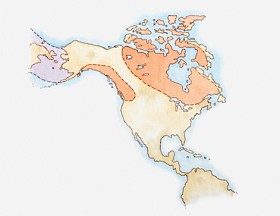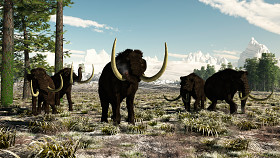
The most widely accepted theory is that the earliest visitors to North America (and eventuall our area) followed their hunting quarry over a land bridge from Asia to Alaska. Perhaps 15,000 years ago ice sheets had tied up enough water that sea levels had dropped as much as 300 feet. Following game around the edge of the retreating ice sheets, these wanderers would eventually reach the Berkshires. There is evidence of paleo-Indian inhabitants in Massachusetts 9,000-10,000 years ago[i] – consistent with these overall continental migrations. The ice sheets would have scrubbed off most vegetation, but these early arrivals would probably have been following and dinning well on giant, slow moving and now extinct game such as Mastadons and Woolly Mammoths.

Initially they probably conducted themselves in the new land similarly to the way they conducted themselves in Siberia. They probably would have traveled in small bands of 15-50 using spears to hunt game including many large animals now extinct – mammoths, mastodons – as well as caribou, moose and the deer still here today. Archaeological evidence shows evidence of transient settlement at water holes where the game they sought would have congregated. The extinction of most of the giant beasts that originally occupied the continent may have been related to climate change, but surely these wiley new bipeds played a part as well. In any case the sweeping plains and easy, massive kills eventually disappeared.
[i] Bidwell House talk on Kampoosa Bog, Chapter 2 – Massachusetts 101
For more information see:
American Colonies: The Settling of North America, by Alan Taylor; The Penguin History of the United States; Eric Foner, editor;2002; Published by Penquin Books USA, 375 Hudson Street, NY, NY 10014, Lincoln DExter (need pub data), Extinct animals (need pub reference)